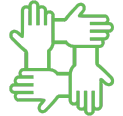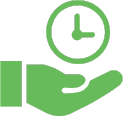PROJECT OVERVIEW
BrewCo was losing retail candidates at twice the industry’s drop-off rate, with many quitting early or opting for a faster competitor. The result? Staffing gaps, negative feedback, and serious strain on the candidate experience.
Complaints of unresponsiveness and poor retention made it harder to attract top talent — threatening workforce stability and weakening BrewCo’s employer brand.
I discovered there was no consistent hiring process across the retail network — no shared baseline, no central record, and scattered feedback about what worked (or didn’t).
Addressing these challenges was critical to BrewCo’s broader goal of creating a consistent, efficient, and candidate-centered retail hiring process.
What was breaking down in the candidate experience?
How could we redesign hiring to be faster, more candidate-centered, and aligned with BrewCo’s brand promise?
I addressed these challenges through research, resulting in 4 strategic aims:
🎯 Build a Scalable Research Foundation
Create a single source of truth to support hiring across BrewCo's retail network.
🎯 Aligning Stakeholders on Candidate Needs
Drive decisions using real candidate pain points to prioritize key improvements.
🎯 Secure Cross-Functional Buy-In
Translate user needs and process gaps into organization-wide commitment and resources.
🎯 Elevate BrewCo's Employer Brand
Reframe hiring as a brand experience aligned with BrewCo’s customer-first values.

Budget
$1M

Team
Lead UX Researcher, 1 Lead UX Designer
1 TA Partner, 2 Hiring Managers
1 Senior HR, 1 Onboarding Specialist

Timeline
3 months
Research Goals & Approach
We used a multi-phase research approach to identify drop-off points, surface misalignments, and ensure the redesign reflects real candidate needs.
RG1: Analyze early attrition points in the current hiring journey to uncover root causes and improve retention.
RG2: Identify gaps between candidate expectations and the current hiring journey to surface pain points and reveal opportunities.
RG3: Map the end-to-end retail hiring journey to create a unified framework grounded in candidate mental models and cross-team alignment.
Stakeholder Interviews
Requirements Gathering
Baseline Mapping Structure
Assumptive Mapping Workshop
18 1:1 Interviews
Surveys
Desirability Matrix
Thematic Analysis
Hiring Experience Map
Internal & External Stakeholder Presentations
⚙️Process | 📦 Artifacts ▸
Intent
Synthesized fragmented hiring data to uncover hidden touchpoints and systemic breakdowns, driving targeted design decisions.
⚙️ Mapped the candidate hiring journey using insights from recruiters, candidates, and stakeholders, to pinpoint critical friction points.
⚙️ Diagnosed workflow bottlenecks and inconsistencies to improve user efficiency and candidate experience.
📦 As-Is Assumptive Map v0
⚙️Process | 📦 Artifacts ▸
Intent
Align cross-functional teams to challenge assumptions, surface knowledge gaps, and identify opportunities to improve hiring outcomes.
⚙️ Facilitated collaborative workshops to visualize the hiring journey and surface assumptions and process gaps.
⚙️ Aligned stakeholders across teams to build shared understanding of the hiring journey and uncover actionable opportunities.
📦 As-Is Assumptive Map
⚙️Process | 📦 Artifacts ▸
Intent
Conduct mixed-methods research to validate assumptions, quantify candidate expectations, and deliver actionable insights to improve the hiring experience.
⚙️ Conducted 18 semi-structured 1:1 candidate interviews to validate assumptions and uncover behavioral insights.
⚙️ Ran surveys and desirability matrices to quantify candidate expectations and identify gaps at scale.
⚙️ Synthesized qualitative data via affinity mapping to highlight friction points in the hiring journey.
📦 Interview Guide, Survey, Desirability Matrix, Thematic Analysis
⚙️Process | 📦 Artifacts ▸
Intent
Synthesized research insights into a hiring journey map, revealing opportunities that address user pain points and drive process transformation.
⚙️ Led cross-organizational walkthroughs to align stakeholders and translate research into actionable design solutions.
⚙️ Designed a unified hiring workflow to enhance efficiency and accelerate digital adoption.
📦 Experience Map, Presentations
Challenges
Positioned research to expose critical gaps, unite teams, and shape the hiring roadmap.
Aligned research insights to KPIs (drop-offs, offer declines), converting them into business priorities that reduced churn.
Mapped candidate mental models to reveal drop-offs and gaps—validating the need for empathetic design.
Built a shared journey-mapping framework to align teams, reduce friction, and streamline hiring—improving clarity and speed.
When applying, I’m in a flow, and I'm tired. If the form is too long or buggy, I just give up — on to the next.
– Candidate 2
Key Discoveries
Overwhelming application flow & team blindspots
Insight 1: Candidates reach the application overwhelmed and low on patience—yet teams expect time, energy, and tolerance for friction. ▸
- The application is the critical midpoint of the candidate’s journey.
- Long or buggy forms break momentum, especially on the go.
- Interruptions cause a permanent drop-off.
Solution 1: Simplify and streamline application flow to reduce effort, prevent errors, and enable faster completion.
Early-stage abandonment & friction triggers
Insight 2: Early abandonment happens when posts feel outdated, navigation confuses users, and application starts are complex. ▸
- Outdated or inaccurate postings erode trust and drive drop-off.
- Candidates arrive at applications emotionally taxed.
- Lengthy or glitchy forms break momentum and increase abandonment.
Solution 2: Indicate job postings are up-to-date, simplify navigation, and ease application start. ▸
- Show only active job posts with clear details (must-haves, differentiators, personal fit) to build trust.
- Ease application start by simplifying account creation steps.
- Simplify navigation to maintain momentum and reduce unnecessary friction.
Communication neglect leads to offer loss
Insight 3: When updates stall or next steps aren’t clear, candidates feel ignored, lose interest, and accept competing offers. ▸
- Silence after 10 days post-application signals rejection to most candidates
- Delays over 7 days post-interview cause candidates to default to the next competing offer.
Solution 3: Set clear timelines and close communication gaps to prevent candidate drop-off. ▸
- Set timeline expectations at each stage.
- Send timely updates via email or applicant portals.
- Close the loop fast to reduce uncertainty.
How candidates search and select job listings
Insight 4: Candidates follow a sequential search-to-filter strategy when evaluating job listings. ▸
They scan for:
- Must-haves (role, location)
- Key differentiators (wage, recency, brand)
- Personal fit (flexibility, benefits)
Solution 4: Reorder job posting content to match how candidates evaluate listings. ▸
- Surface must haves first (e.g., role and location).
- Introduce key differentiators (e.g., compensation and recency).
- Highlight personal-fit cues early (e.g., flexibility) .
Candidates' mental model discovery
Insight 5: Candidates' experience nested loops at each hiring stage, not a simple linear journey. They move forward only when a key moment triggers their progress. ▸
The 5 key moments that shaped candidates’ mental model of the hiring journey:
- Discovering a relevant job opportunity
- Completing and submitting the application
- Receiving timely communication updates
- Participating in the interview process
- Receiving a timely offer
Solution 5: Design key moments to reduce effort, ease decisions, and remove blockers - so candidates keep moving forward. ▸
To ensure momentum:
- Minimize friction at each catalyst — reduce blockers that delay action or decisions.
- Provide clear, timely guidance — help candidates act confidently and keep progressing.
- Monitor catalyst completion — identify early drop-offs and address them through targeted improvements.
